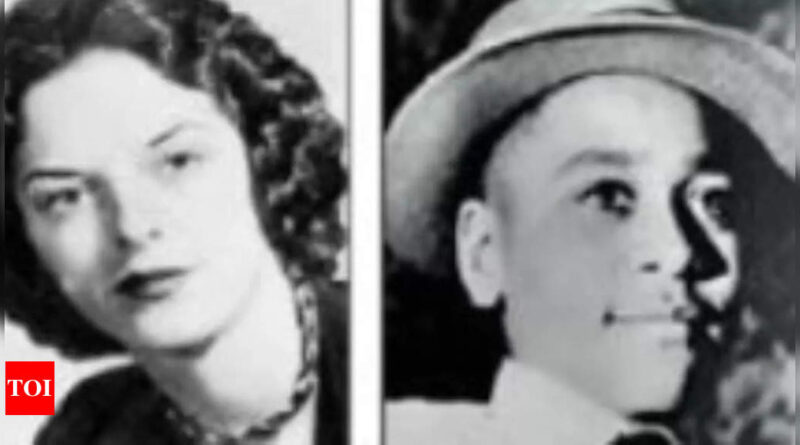Carolyn Bryant Donham, whose accusations led to the murder of Emmett Till, dies at 88 – Times of India
Only two people knew exactly what happened during the minute they were alone together in the general store in Money, Mississippi, on August 24, 1955. One, Emmett Till, a black teenager visiting from Chicago, died four days later, at 14, in one of the most epochal murders in American history.
The other was Carolyn Bryant. She was the 21-year-old white proprietress of the store where, according to her testimony in the September 1955 trial of her husband and his half-brother for the murder, Till made a sexually suggestive remark, grabbed her roughly by the waist and let loose a wolf whistle. Now Bryant has died, at 88. The Calcasieu Parish coroner’s office in Louisiana, confirmed the death of Bryant, more recently known as Carolyn Bryant Donham, on Tuesday. No further information was provided.
With Donham’s death, thetruth of what happened that August day may never be clear. In 1988, she admitted that she had perjured herself on the witness stand to make Till’s conduct sound more threatening than it actually was — serving, in the words of the historian to whom she made the admission, as “the mouthpiece of a monstrous lie”.
She told the historian, Timothy B Tyson, that she had fabricated the most inflammatory parts of her testimony at the behest of defence lawyers and her husband’s family. “She said with respect to the physical assault on her, or anything menacing or sexual, that that part isn’t true,” Tyson, told CBS network in 2017.
But in an unpublished memoir that surfaced last year, Donham stood by her earlier description of events, though she said she had tried to discourage her husband from harming Till. “He came in our store and put his hands on me with no provocation,” she wrote. “Do I think he should have been killed for doing that? Absolutely, unequivocally, no!”
The Till family said the account was rife with inaccuracies. Till’s murder was a watershed in US race relations. Coverage of the killing and its aftermath inspired anguish and outrage, helped propel the modern civil rights movement and ultimately contributed to the demise of Jim Crow (laws introduced in the southern US in the late 19th and early 20th centuries that enforced racial segregation).
A former beauty queen described in the news media asbeing poor and little educated in 1955, Bryant was a product of her time. Describing him with a racial slur — as recorded in a trial transcript — she said Till had come into the store and “put his left hand on my waist, and he put his other hand over on the other side. ” She added, “He said, ‘What’s the matter, baby? Can’t you take it?’” Bryant further testified that Till had made an obscene remark, which she refused to repeat in court, about his sexual prowess with white women. Her testimony carried the implication that she feared being raped. “I was just scared to death,” she testified.
After deliberating for little over an hour, the all-white, all male jury acquitted her husband, Roy Bryant, and his half brother JW Milam. Bryant, who testified for the defence, wasn’t charged. Secure in the knowledge that double jeopardy would attach, the men admitted the killing the next year in a Look magazine article for which they were paid.
The other was Carolyn Bryant. She was the 21-year-old white proprietress of the store where, according to her testimony in the September 1955 trial of her husband and his half-brother for the murder, Till made a sexually suggestive remark, grabbed her roughly by the waist and let loose a wolf whistle. Now Bryant has died, at 88. The Calcasieu Parish coroner’s office in Louisiana, confirmed the death of Bryant, more recently known as Carolyn Bryant Donham, on Tuesday. No further information was provided.
With Donham’s death, thetruth of what happened that August day may never be clear. In 1988, she admitted that she had perjured herself on the witness stand to make Till’s conduct sound more threatening than it actually was — serving, in the words of the historian to whom she made the admission, as “the mouthpiece of a monstrous lie”.
She told the historian, Timothy B Tyson, that she had fabricated the most inflammatory parts of her testimony at the behest of defence lawyers and her husband’s family. “She said with respect to the physical assault on her, or anything menacing or sexual, that that part isn’t true,” Tyson, told CBS network in 2017.
But in an unpublished memoir that surfaced last year, Donham stood by her earlier description of events, though she said she had tried to discourage her husband from harming Till. “He came in our store and put his hands on me with no provocation,” she wrote. “Do I think he should have been killed for doing that? Absolutely, unequivocally, no!”
The Till family said the account was rife with inaccuracies. Till’s murder was a watershed in US race relations. Coverage of the killing and its aftermath inspired anguish and outrage, helped propel the modern civil rights movement and ultimately contributed to the demise of Jim Crow (laws introduced in the southern US in the late 19th and early 20th centuries that enforced racial segregation).
A former beauty queen described in the news media asbeing poor and little educated in 1955, Bryant was a product of her time. Describing him with a racial slur — as recorded in a trial transcript — she said Till had come into the store and “put his left hand on my waist, and he put his other hand over on the other side. ” She added, “He said, ‘What’s the matter, baby? Can’t you take it?’” Bryant further testified that Till had made an obscene remark, which she refused to repeat in court, about his sexual prowess with white women. Her testimony carried the implication that she feared being raped. “I was just scared to death,” she testified.
After deliberating for little over an hour, the all-white, all male jury acquitted her husband, Roy Bryant, and his half brother JW Milam. Bryant, who testified for the defence, wasn’t charged. Secure in the knowledge that double jeopardy would attach, the men admitted the killing the next year in a Look magazine article for which they were paid.



